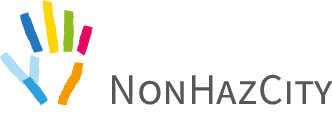The NonHazCity 2 Project was a continuation of ‘Innovative management solutions for minimizing emissions of hazardous substances from urban areas in the Baltic Sea Region’ project implemented in the years 2016-2019. One of the goals of the extension was to attract businesses in implementing good practices in their management of chemicals. Already in 2017 project partners started to seek a good incentive for business. ISO 14001 certification and EMAS registration appeared to be a promising option.
Firstly, both standards are not prescriptive and request organizations to determine significant environmental aspects and related risks and opportunities according to their own criteria. In case chemicals (no matter if in the processes or products) are classified as significant aspects, both ISO 14001 and EMAS offer a set of management tools to minimize risks and enhance opportunities.
Secondly, both standards require organizations to demonstrate continual improvement, thus organizations need inspiration on where to improve.
Thirdly, ISO 14001 certification and EMAS registration for over 25 years have become widely recognized and perceived as the indication of reliability in business and was implemented at about 500 thousand sites worldwide.
With these three factors it has been decided to assist businesses in incorporating management of chemicals in their environmental management systems. As a consequence one of the important outcomes of the NonHazCity2 project was the Guide on Management Of Chemicals As Part Of The Environmental Management. The principles described in this guide are primarily applicable to organisations that use chemicals in their activities, in particular:
- industrial users, i.e. entities using chemicals as auxiliaries (e.g. users of coolants, cleaning agents, reagents) or to produce a mixture or an article in which the chemicals are incorporated,
- non-industrial users, i.e. those using chemicals in professional activities other than industrial processes, e.g. craftsmen, professional service providers, as well as public administration.
From the point of view of the user of the guide, it is also important that it has been prepared for people working for organisations that:
- ·maintain an EMS (based on the requirements of the ISO 14001 standard or the EMAS Regulation), but so far have had little coverage of the management of chemicals, or
- see no need to maintain a formal EMS but seek inspiration for better management of chemicals.
The guide has been also prepared to be used by auditors acting on behalf of certification bodies (including EMAS verifiers) who seek knowledge of good practices applied in various areas related to environmental management.
We hope the Guide will become an inspiration for organizations to improve their management of chemicals and for standardization community to implement this environmental topic into their work plans.

